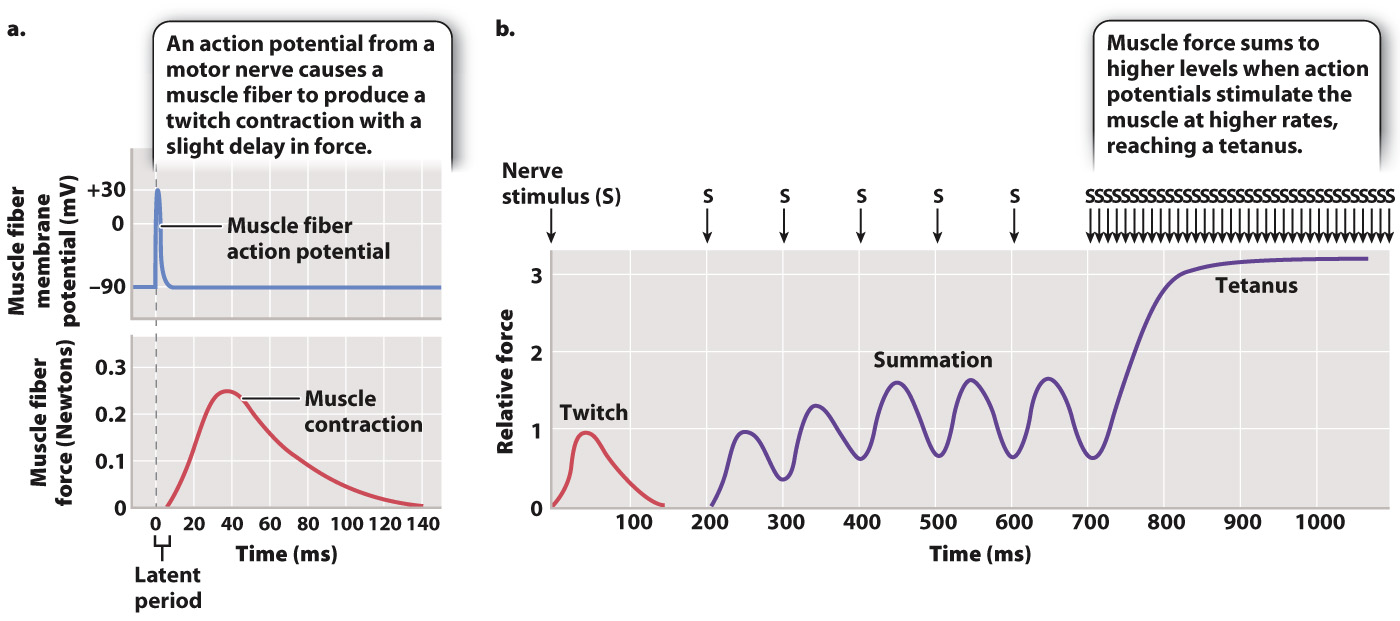Muscle force is summed by an increase in stimulation frequency and the recruitment of motor units.
How do animals vary the amount of force exerted by a muscle? As we have seen, skeletal muscles are stimulated by motor nerves, which conduct action potentials to the neuromuscular junction. The force exerted by a muscle depends on the frequency of stimulation by the motor nerve. As action potentials become more frequent, the amount of calcium that is released to activate cross-
A single action potential results in a twitch contraction of a certain force (Fig. 37.12a). If sufficient time is allowed for the muscle to pump Ca2+ back into the sarcoplasmic reticulum, the contraction ends, force falls to zero, and a second stimulus can elicit a twitch contraction of the same force. However, if a second action potential arrives before the muscle has relaxed, a greater force is produced because Ca2+ remains within the myofibrils to activate more cross-


At a sufficiently high stimulation frequency, muscle force reaches a plateau and remains steady as stimulation continues. This muscle contraction of sustained force is called a tetanus. Measurements in animals indicate that skeletal muscles commonly produce tetanic contractions, which generate steady and large forces. Tetanus is a normal physiological response of a muscle, but it can also be induced by a toxin from the bacterium Clostridium tetani, so named because it causes severe muscle spasms, particularly of the jaw, chest, back, and abdomen.
A motor neuron and the population of muscle fibers that it innervates are collectively termed a motor unit (Fig. 37.13). Motor units can include relatively few to several hundred muscle fibers. The number of muscle fibers innervated by a given motor nerve, and hence the size of the motor unit, affects how finely a vertebrate muscle’s force can be controlled. For example, finger muscles have small motor units allowing fine adjustments in muscle force, whereas leg muscles have large motor units providing larger adjustments in force. Together with stimulation frequency, a vertebrate muscle’s force output depends on the number of motor units (and therefore the number of muscle fibers) that are activated. Within each motor unit, muscle fibers generally share similar contractile and metabolic properties. Differences in these properties can give muscles very different capabilities, as discussed in the next section.
796
Quick Check 4 What are the two mechanisms by which the force of contraction can be increased in vertebrate muscles?
Quick Check 4 Answer
The force of contraction can be increased by increasing the frequency of stimulation of the muscle by the motor neuron (increased firing frequency) and by activating a greater number of motor neurons to recruit more motor units (and thus, more muscle fibers).